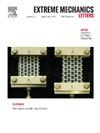Do slip-weakening laws shapes influence rupture dynamics?
IF 4.3
3区 工程技术
Q2 MATERIALS SCIENCE, MULTIDISCIPLINARY
引用次数: 0
Abstract
To model rupture dynamics, a friction law must be assumed. Commonly used constitutive laws include slip-weakening laws which are characterized by a drop from static to dynamic frictional stress over a critical slip distance. Within this framework, the prevailing understanding asserts that the frictional behavior is solely controlled by the fracture energy — the area beneath the frictional stress versus the cumulative slip curve. In particular, it is claimed that the curve’s shape itself has no influence on the system’s response. Here we perform fully dynamic rupture simulations to challenge prevailing beliefs by demonstrating that the constitutive law shape exerts an intimate control over rupture dynamics. These results are confirmed using two independent numerical schemes (spectral boundary integral and finite element methods). For a consistent fracture energy but varying constitutive weakening law shapes, the slip velocity profile is different: each abrupt slope transition leads to the localization of a distinct velocity peak. For example, in the case of a bilinear slip-weakening law featuring two different slopes, the rupture exhibits two distinct velocity peaks. This phenomenon arises from the transition between a constant weakening rate to another. We show that ruptures with the same fracture energy but different constitutive law shapes may respond differently to stress barriers, especially when cumulative slip is below the critical slip . In these cases, variations in effective fracture energy across different laws lead to differing outcomes: under one law, a rupture may propagate past a barrier, while under another, it may arrest. These findings underscore the critical role of constitutive law shape on rupture dynamics, influencing the response to small-scale asperities and heterogeneities and to larger-scale barriers, and highlighting the importance of both fracture energy and weakening mechanisms for seismic hazard assessment.
滑移弱化规律形状是否影响破裂动力学?
为了模拟破裂动力学,必须假设一个摩擦定律。常用的本构律包括滑移弱化律,其特征是在临界滑移距离上从静摩擦应力下降到动摩擦应力。在这一框架下,普遍的理解认为,摩擦行为完全由断裂能控制,即摩擦应力下的面积与累积滑移曲线。特别是,曲线的形状本身对系统的响应没有影响。在这里,我们进行了完全动态的破裂模拟,通过证明本构律形状对破裂动力学具有密切的控制来挑战普遍的观点。用两种独立的数值格式(谱边界积分法和有限元法)证实了这些结果。在断裂能一致但本构弱化规律形状不同的情况下,滑移速度剖面不同:每次陡变都会导致一个不同速度峰值的局部化。例如,在具有两个不同斜率的双线性滑移减弱规律的情况下,破裂表现出两个不同的速度峰值。这种现象是由一个恒定的减弱速率向另一个恒定的减弱速率过渡而产生的。研究表明,具有相同断裂能但不同本构律形状的断裂对应力障碍的响应可能不同,特别是当累积滑移低于临界滑移Dc时。在这些情况下,不同规律下有效断裂能的变化会导致不同的结果:在一种规律下,破裂可能会越过屏障,而在另一种规律下,破裂可能会停止。这些发现强调了本构律形状对破裂动力学的关键作用,影响对小尺度非均质性和大尺度障碍的响应,并强调了裂缝能量和减弱机制对地震危害评估的重要性。
本文章由计算机程序翻译,如有差异,请以英文原文为准。
求助全文
约1分钟内获得全文
求助全文
来源期刊

Extreme Mechanics Letters
Engineering-Mechanics of Materials
CiteScore
9.20
自引率
4.30%
发文量
179
审稿时长
45 days
期刊介绍:
Extreme Mechanics Letters (EML) enables rapid communication of research that highlights the role of mechanics in multi-disciplinary areas across materials science, physics, chemistry, biology, medicine and engineering. Emphasis is on the impact, depth and originality of new concepts, methods and observations at the forefront of applied sciences.
 求助内容:
求助内容: 应助结果提醒方式:
应助结果提醒方式:


